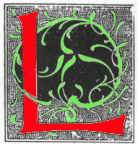
ike all undergraduate graphic design students, I first heard the name “John Ruskin” in a design history survey course, as what now appears in memory a mere footnote to the brief section of the course that introduced us to the Arts & Crafts movement. I remember us suffering of boredom with all of this Victorian, Romantic nonsense—anxiously waiting to get to the ‘good’ design stuff, i.e. the exciting sources of Modernism in the early-twentieth-century avant garde movements and, later, the Bauhaus. But first we had to suffer hearing about a bunch of utopian-dreaming craftsmen and some highly verbose Victorian art critic who was their inspiration. William Morris and Edward Burne-Jones, we learned, were so swept up by Ruskin’s “The Nature of Gothic,” a chapter from The Stones of Venice, that they abandoned whatever they had studied at Oxford to pursue the decorative arts, and later found what was to be called the Arts & Crafts movement. That was about the extent of it, for all intents and purposes. I vaguely remember our professor suggesting that we read The Stones of Venice, or perhaps The Seven Lamps of Architecture (text). I distinctly remember that none of us actually did!
Thus did the name “John Ruskin” disappear into the dusty corners of my busy graphic designer’s mind, as I spent the ensuing 20 years solving communication problems for my clients, guided by the modernist notion that my graphic design could, and would undoubtedly, beautify a world based in commerce. Then I started teaching.
Teaching had not been a goal of mine. In 1998, I was dragged into it by a friend, pretty much kicking and screaming. Turns out I was good at it, and it was good for me. As I delved ever further into the graphic design history course that I was teaching, something in Arts & Crafts philosophy awoke, as if from hibernation, within me. For some inexplicable reason it was becoming important, even pivotal.
Around this time, the changes in the graphic design profession began taking a toll on my spirit. The ‘art’ of designing seemed subsumed by commercial priorities, marketing data, and focus groups. Further, as our profession became digitized—no longer the physical challenge of ruling pens and ink, the delight of beautiful typography pasted onto cold-press boards, and the logic of hand-registered overlays translating clearly into printing plates—so disappeared the craft reward of our work. In retrospect it is no mystery, then, that the faint glimmer of Arts & Crafts reignited for me into a beam, then a guiding beacon.
From 2001 to 2004, I pursued an MFA—necessary to continue teaching. Arts & Crafts sensibility occupied a central place in my study plan. I became engrossed in the life and work of Morris and his circle; correspondingly his stature grew in my mind to something of prophet, seeming to occupy exactly the place in the production of things that I was beginning to consider as the lynchpin to a truly rewarding creative life. At one point along the way, I happened to read the Morris’s introduction to his Kelmscott edition of “The Nature of Gothic,” in which Ruskin, he claimed, illuminates the path that must be followed for society to become a happy one. I decided then that I not only must I read the essay in full, but also that I read it in the Kelmscott edition. To my delight, I discovered that a copy from that edition resided not a five-minute walk from my office, in a bequeathed collection at the University of Vermont’s Special Collections Library. So I read Ruskin’s wonderful synthesis of architecture history, natural history, and social critique as Morris insisted I should! I documented my reading of the book for my MFA portfolio with this photo:

Photo by Ms. Prudence Doherty, Special Collections Librarian, Bailey Howe Special Collections at the University of Vermont. I am indebted to Ms. Doherty also for her unflagging assistance in introducing me to numerous volumes from the Kelmscott Press, and related works.
It truly was exciting to read this work from a book that came from Morris’s press—set in a font of his design, and produced in accordance with his strict specifications for ink, paper, and binding. Having studied letterpress as an undergraduate, I could readily appreciate the challenges in achieving such a work, and at the same time accept Ruskin’s notion of embracing ‘imperfection’ in made objects—ragged, misaligned deckle page edges, buckled paper, irregular-tone vellum binding—evidence of it being crafted, not simply produced. Ruskin’s words were thus so much more alive in this volume rather than an industrially printed one, even in spite of Morris’s spiky letterforms bouncing around my eyes!
The craft object aside, John Ruskin’s writing captivated me. I proceeded to read more, and now am entrenched in the Library Edition, a complete set of which also resides at the University of Vermont Library. Guided by various references, I read the ones most germane to my immediate interests first: The Stones of Venice (parts); The Two Paths; Unto This Last; —and now hope to surmount most of his works by the end of my sabbatical study in the coming year.
I sense in Ruskin a painful truth, one we must face if we hope for any constructive relation between work and earning a living. The role of creativity is the key, and education is the means, with a reverence of nature being the overarching guiding light. That he is so unknown, even within most of the academic community (at least in my experience), is deeply troubling. I hope to bring him back into a more central place on the stage within my immediate academic circle, and hopefully beyond, especially at the boundary between academics and skills training, as he had dreamt for in his own time. Those loftier aims notwithstanding, I am certainly very glad that I went back to that footnote, and so discovered John Ruskin.
Last modified 7 April 2024